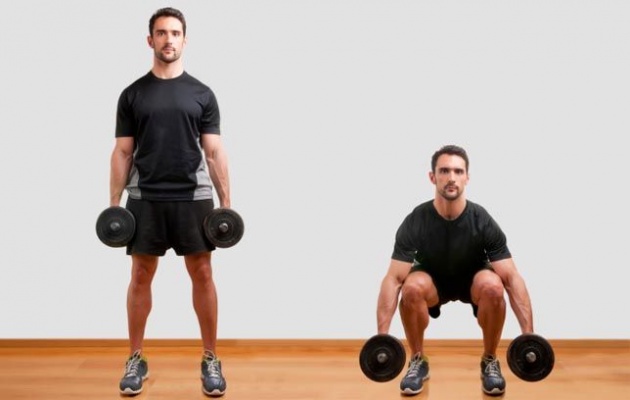Squatting a heavy barbell takes a ton of strength in your quads and glutes, but that's only the half of it. "If you're not maintaining or improving your mobility in your joints while you're building up those muscles, your performance will suffer and put you at risk for injury," says BJ Gaddour, C.S.C.S., CEO of Men's Health StreamFIT.
The three major areas you need to monitor are your ankles, knees, and hips. Use these three easy—albeit crazy-looking—stretches to improve your mobility and boost your squat performance.
Ankles
"If I told you to squat a loaded barbell while standing on your toes, you'd think I'm insane," says Gaddour. "But unfortunately, if you have tight ankles, you may do this without even realizing it."
Tight, immobile ankles won’t bend enough to allow you to push your knees out over your toes, and sit back between your legs to get into the proper position. In other words, you limit how deep your squat can be.
"To compensate, you end up lifting your heels off of the floor in order to force yourself into the proper position," says Gaddour. As a result, you create an unstable foundation for the move.
Fix it by performing the drill below. "The resistance band pulls on your upper ankle to unlock extra space in the joint, while pressing your knee out over your toe helps you to create more flexibility in the area of your Achilles tendon," he says. Hold for 30 seconds on each side.
Knees
When it comes to performing a deep squat, how much your knees can bend can also hold you back. "If your knees—or the muscles above and below them—are tight, getting into a deep squat position is going to be difficult and painful," says Gaddour. "And it will affect those with current or previous knee injuries the most."
The limitation in your movement will force you to adopt poor form just to get into a deep squat position. As a result, you'll place undue stress on other parts of your body—like your ankles and hips.
Not only will this up your risk for injury, but you'll also inhibit yourself from recruiting maximum muscle to move the weight.
To avoid junking up your joints, create space in your knees to enhance mobility by using the drill below. "Placing a towel or your arm behind your knee can help you stretch it further than you could if you bent it regularly," says Gaddour.
"The hips may be the most prominent limitation for people when it comes to squatting," says Gaddour. Why? Because when you sit for many hours a day with your thighs at a 90-degree angle from your torso, your hip flexors adapt to that position—which causes tightness.
"Think about it: How often do you find yourself getting into a deep squat outside the gym?" asks Gaddour. "Since you're likely not as accustomed to the squatting position as you are to sitting, you need to help your hips open up to allow more range of motion."
Otherwise, your tight hip flexors can cause your back to round at the bottom of the squat, putting your spine at risk for injury.
To mobilize your hips, use this band-assisted movement in the video below. "The band will help you adapt to a deep-squat position, while lying on your back will take pressure off of it.”




